There’s something very eerie about abandoned places. Their isolation and backstories are usually fascinating, and while most of these places are off-limits, the most courageous among us usually find a way to get inside and send their bravely taken images to the rest of the world. List 25 has covered abandoned places before, but we decided to look much further to find 25 particularly creepy abandoned places that have long since passed their heyday. While some have been redeveloped or demolished, their legacy remains vivid in the eyes and minds of the world.
Here are the 25 creepiest abandoned places on Earth.

Bhangarh Fort, India
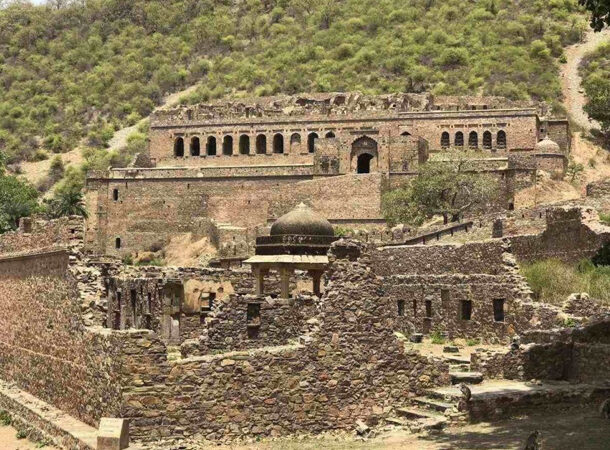 https://timesofindia.indiatimes.com/travel/destinations/5-mysterious-facts-about-bhangarh-that-will-scare-you-to-bits/photostory/85977969.cms
https://timesofindia.indiatimes.com/travel/destinations/5-mysterious-facts-about-bhangarh-that-will-scare-you-to-bits/photostory/85977969.cms The Bhangarh Fort, which is said to be the most haunted spot in India, was built in the 17th century by the monarch Bhagwant Das in the Indian state of Rajasthan. Legend tells us that his daughter turned down a local sorcerer who approached her with a magical potion. In an unusual turn of events, while grieving the loss, he failed to detect a boulder sliding down his path and was crushed to death. Moments before his death, he cursed the entire kingdom of Bhangarh for perishing and dying in agony. Let us fast-forward four centuries. There have been numerous reports of paranormal activity and stories of tourists meeting tragic ends, leading many to believe that the curse, in fact, exists. The government forbids any foreigners to be in the area once the sun sets.
The Ryugyong Hotel, North Korea
 https://edition.cnn.com/style/article/ryugyong-hotel-architecture-origins/index.html
https://edition.cnn.com/style/article/ryugyong-hotel-architecture-origins/index.html The Ryugyong Hotel, also known as the Yu-Kyung Hotel or the 105 Building, is one of the world’s creepiest abandoned buildings. According to the Guinness Book of World Records, it is also the tallest vacant building in the world. The building’s construction began in 1987 and was abruptly halted in 1992. Construction resumed in 2008 but was stopped again in 2011. The Ryugyong reopened in 2018 after LEDs were put on its facade, transforming it into Pyongyang’s largest light show and a propaganda machine. It features a four-minute video depicting North Korea’s history and various political slogans, while the cone at the top displays a massive North Korean flag. The question is, will it ever be open? Construction of the building is still in progress, and it has never been occupied.
St George’s Church, Czech Republic
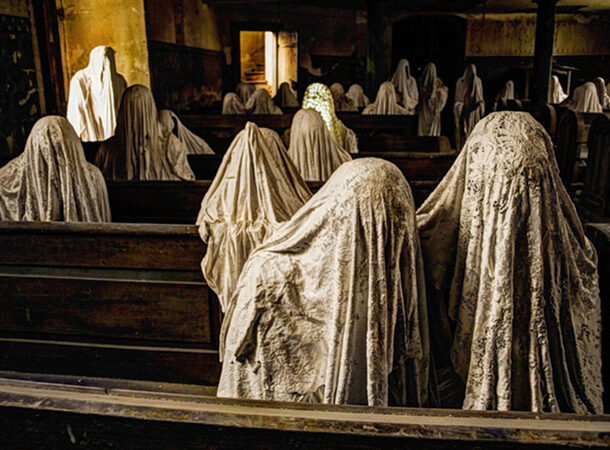 https://www.insider.com/abandoned-church-ghosts-czech-republic-st-georges
https://www.insider.com/abandoned-church-ghosts-czech-republic-st-georges The now-dilapidated St George’s Church in the Czech Republic is not only creepy from the outside but also very much so on the inside. The church was closed down in the 1960s, but scary ghostly shrouded statues now inhabit it. When the church’s roof fell in 1968, the residents saw it as a bad omen and boarded it up while proceeding to have their services outside the church. Even though the church was abandoned, residents wanted it to be restored. Jakub Hadrava, an artist, was commissioned to create a work of art to collect funding for the project. He created several plaster ghosts, which were placed in the church in 2014. (The Nun, anyone?)
Pripyat, Ukraine/Belarus Border
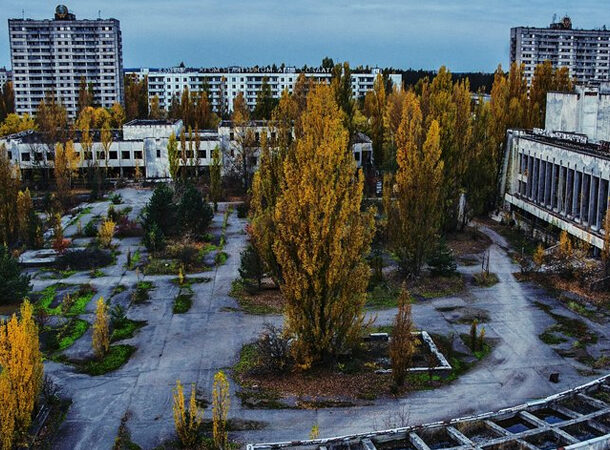 https://www.theguardian.com/cities/gallery/2016/apr/05/inside-abandoned-city-pripyat-30-years-chernobyl-in-pictures
https://www.theguardian.com/cities/gallery/2016/apr/05/inside-abandoned-city-pripyat-30-years-chernobyl-in-pictures Pripyat was established in 1970 as a Soviet Nuclear City to accommodate workers for the nearby doomed Chornobyl Nuclear Power Plant. It was named after the adjacent Pripyat River and was incorporated as a city in 1979, and had a population of 49,000 men, women, and children. As a result of the now-infamous nuclear meltdown at the facility in 1986, the entire city had to be evacuated. The Ministry of Emergencies in Ukraine currently oversees access to the city as well as all operations within the Chernobyl Exclusion Zone. Since 1986, radiation levels have decreased significantly, with equivalent doses ranging from 1 to 336 microsieverts per hour. However, the city remains the epitome of a ghost town.
Kayakoy, Turkey
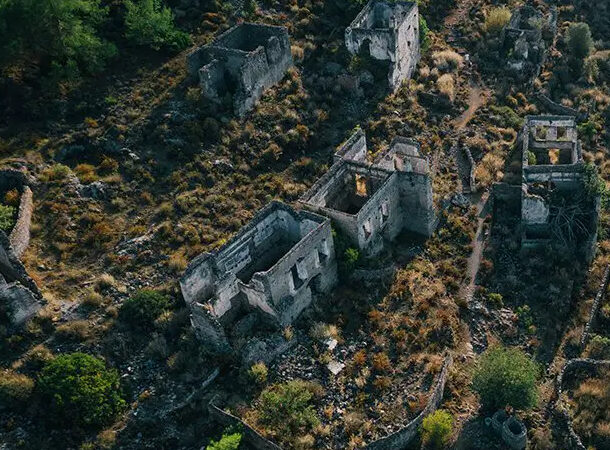 https://theculturetrip.com/europe/turkey/articles/the-story-behind-turkeys-abandoned-religious-ghost-town/
https://theculturetrip.com/europe/turkey/articles/the-story-behind-turkeys-abandoned-religious-ghost-town/ The abandoned town of Kayakoy has a truly depressing past. The town, which lies near the popular tourist hotspots of Olu Deniz and Fethiye, used to have a vibrant and energetic community before a series of tragedies befell them. Its first drawback came as WWI ravaged the world, followed by the collapse of the Ottoman Empire and, shortly thereafter, the attempted conquest of Anatolia by the Greeks. However, the town’s final death blow was the Turkish-Greek Population Exchange Treaty. In its terms, Greek Christians were forced to leave Turkey, while all Muslim Turks were forced to leave Greece. Adding insult to injury, an earthquake hit the area, forcing the last remaining residents to leave.
Houtouwan, China
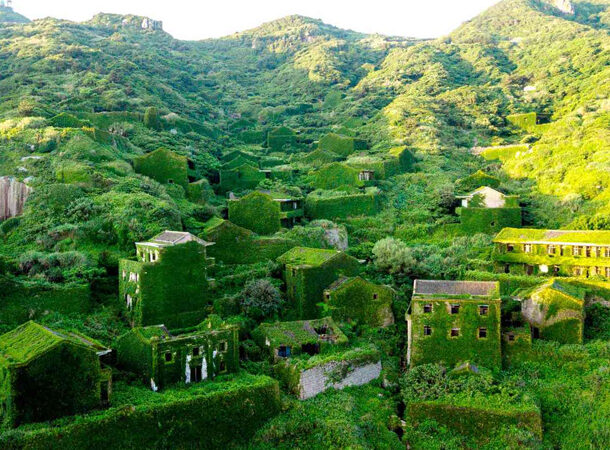 https://edition.cnn.com/travel/article/houtouwan-china-ghost-village/index.html
https://edition.cnn.com/travel/article/houtouwan-china-ghost-village/index.html Houtouwan, a fishing village in the Shengsi archipelago near Shanghai, once had a bustling population of more than 3,000 people. However, its residents, mostly fishermen, and their families, began leaving in the 1990s when fish became scarce, and nature covered the empty buildings within three decades. Today, only the most daring tourists venture to the island. Exploring ancient, decaying houses is a popular activity, providing a glimpse into the past with household objects and furnishings that appear to be museum treasures. Many buildings today display warning signs as the surrounding vegetation hastens their decay.
Kolmanskop, Namibia
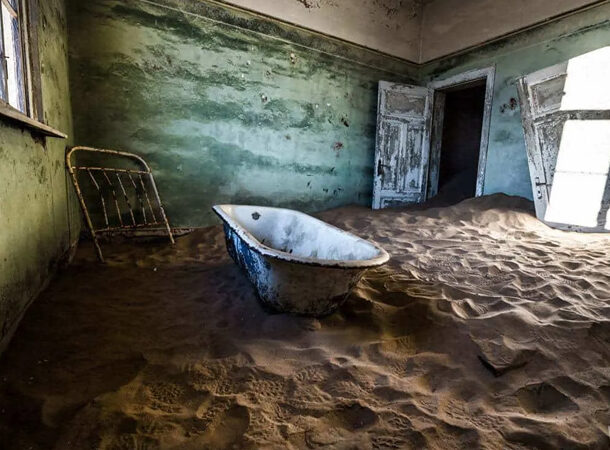 https://www.nationalgeographic.com/travel/article/eerie-fascinating-pictures-kolmanskop-desert-diamond-ghost-town
https://www.nationalgeographic.com/travel/article/eerie-fascinating-pictures-kolmanskop-desert-diamond-ghost-town On April 14, 1908, Zacharias Lewala, a railroad worker, found a diamond in the desert – a discovery that would lead to the founding of Kolmanskop in Namibia. The wealth of the first diamond miners soon transformed the area into a fully functioning German town with a hospital, a four-lane bowling alley, a furniture factory, and the first tramway in Africa. Kolmanskop boomed until the 1920s but experienced a rapid decline after World War I. Diamond prices fell, the diamond fields around Kolmanskop were slowly depleted, and richer diamond deposits were found further south. By 1954, the mining town, once home to 300 German adults, 40 children, and 800 Owambo contract workers, was at the mercy of the forces of nature.
Plymouth, Montserrat
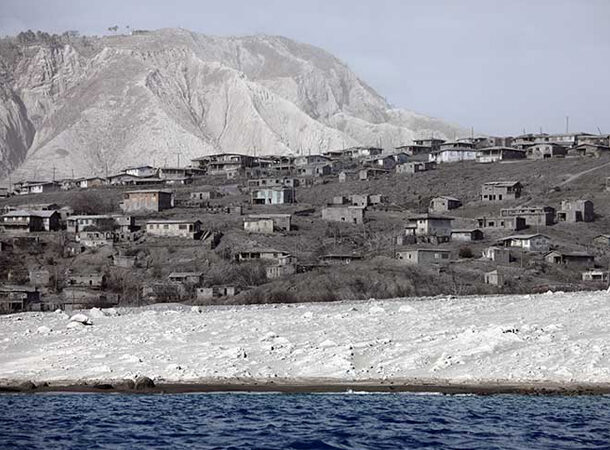 https://www.worldabandoned.com/category/montserrat
https://www.worldabandoned.com/category/montserrat When the Soufrière Hills volcano erupted in 1995, resident of the town of Plymouth, which used to be the capital of Montserrat in the Caribbean, was forced to evacuate. Some residents would eventually return but had to be evacuated again in August 1997, when another eruption destroyed more than 80% of Plymouth, burying it under nearly 5 feet of volcanic ash. During the second eruption, 19 people died, and the town became known as the “Pompeii of the Caribbean.” Many of the town’s residents continue to live in poverty in temporary housing to this day.
Aniva Rock Lighthouse, Russia
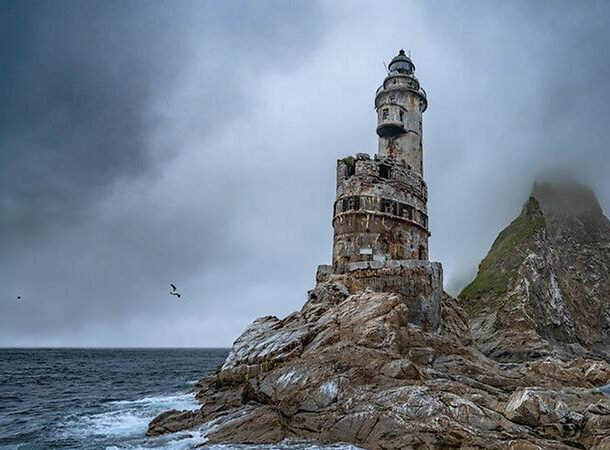 https://www.dailystar.co.uk/news/world-news/inside-eerie-abandoned-nuclear-lighthouse-28691209
https://www.dailystar.co.uk/news/world-news/inside-eerie-abandoned-nuclear-lighthouse-28691209 The Aniva lighthouse is one of Russia’s most remote and difficult-to-access lighthouses. Japan erected it near the southern shore of Sakhalin, a small island east of the Russian mainland, in 1939. The area around the lighthouse often gets engulfed in sea mists, and the region’s unpredictable tides have resulted in several shipwrecks. The haunting lighthouse was decommissioned in 2006 as modern navigation technology rendered its original purpose obsolete. Sadly, time has taken its toll on the Aniva lighthouse, which today lies rusted, ragged, and far from its former glory.
The Moynaq Ship Graveyard, Uzbekistan
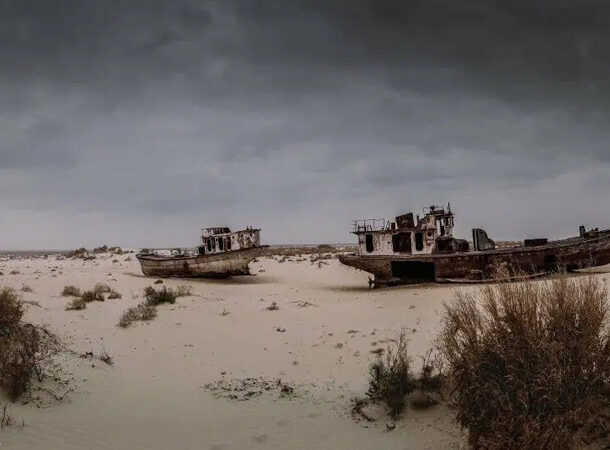 https://nautica.news/the-moymaq-ship-graveyard/
https://nautica.news/the-moymaq-ship-graveyard/ Nothing is more eerie than abandoned objects that appear out of place, like the ships in the Moynaq Ship Graveyard. They found themselves stranded in the desert when the rivers of the Aral Sea were redirected for irrigation purposes. Once a body of water so massive that it spanned 26,300 square miles, it dwindled to less than 10% of its original expanse. The ecological disaster killed the flourishing fishing economy in a few short years. The remaining inhabitants of the area suffered severe health issues as toxic dust storms laden with salt, fertilizers, and pesticides swept across the dead seabeds. Today, the scorching desert heat engulfs dozens of disintegrating ships, while the nearest shore lies nearly 100 miles away.
Bodie, USA
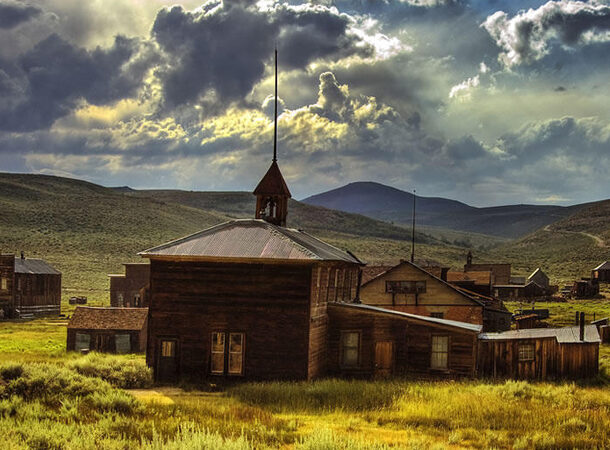 http://www.parks.ca.gov/?page_id=509
http://www.parks.ca.gov/?page_id=509 The Ghost Town of Bodie, which slowly decays in the Sierra Nevada Mountains, is one of the best-preserved old mining towns in the United States. In its heyday, the town had a population of over 10,000 people. It was famous for its lawlessness – daily shootings were commonplace, and barring the saloons, the morgue was the town’s second-best booming business. Bodie became a State Historic Park in 1962 and is more famous today for what is known as the “curse of Bodie.” Legend has it that anyone who takes something from the town will experience misery and misfortune. Interestingly, stolen “souvenirs” frequently find their way back to the local ranger’s station along with letters of apology.
The Paris Catacombs, France
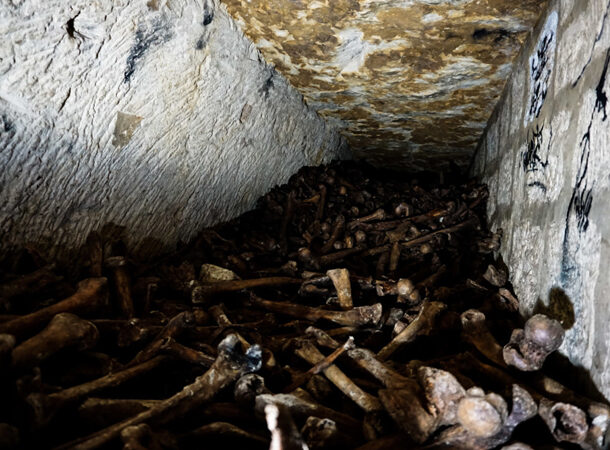 https://culturezvous.com/en/history-paris-catacombs/
https://culturezvous.com/en/history-paris-catacombs/ Nothing could be more terrifying than becoming stuck within a small tunnel hundreds of feet underground, yet it happens regularly within the Paris Catacombs. Only about two miles are open to the public and include the famous ossuaries – the rest of the catacombs stretch for more than two hundred miles in a subterranean network of passageways and tunnels. The prohibited parts of Paris’ catacombs are unmarked and very dangerous. Some locals do enter the catacombs through illegal secret entrances around Paris; however, authorities make no secret that it is prohibited and extremely dangerous. However, despite the risks of urban legends, and myths, there is no shortage of daredevils who explore the catacombs on a daily basis.
Erdstall Tunnels, Europe
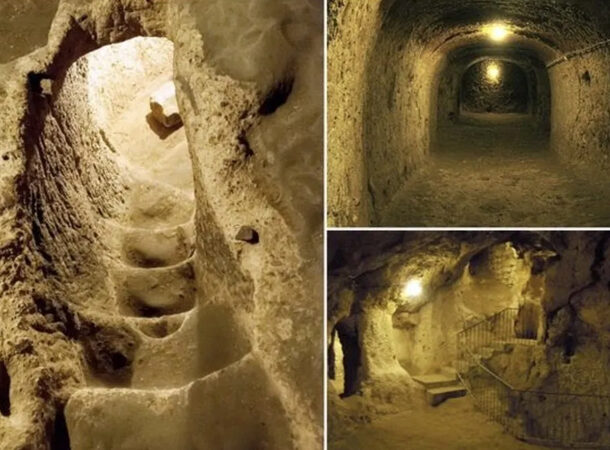 https://www.amusingplanet.com/2017/08/the-mysterious-erdstalls-tunnels.html
https://www.amusingplanet.com/2017/08/the-mysterious-erdstalls-tunnels.html The Erdstall tunnels can be found across a large portion of Europe and are thought to date back to the Middle Ages. With no records indicating their use or purpose, it is widely assumed that robbers and criminals might have used the interconnected network of tunnels as safe houses. Others believe the tunnels served as a prison for evil spirits and played an essential role in religious and spiritual interactions. The tunnels are pretty remote and only a few inches high – definitely not to be entered by anyone with claustrophobia. Because the vast bulk of the labyrinth is hidden in darkness, just a portion of it has been investigated, and only the well-known and explored tunnels may be entered at any given time.
Spreepark, Germany
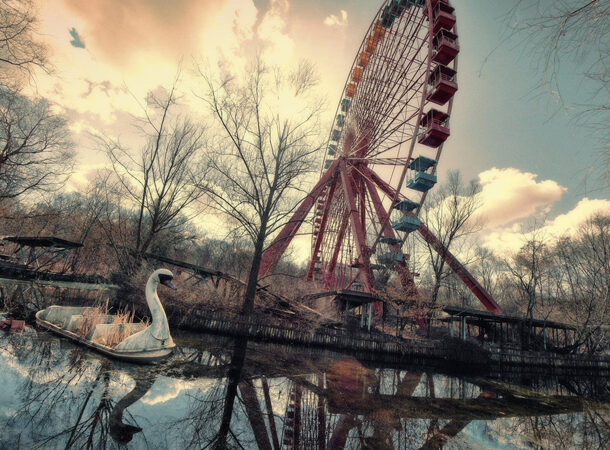 https://www.exberliner.com/berlin/spreepark-history-ddr-amusement-park-norbert-witte/
https://www.exberliner.com/berlin/spreepark-history-ddr-amusement-park-norbert-witte/ This is one of the most terrifying locations in the world, and it never fails to draw attention. This Berlin-based entertainment park, which opened to the public in 1969, received strong opposition as the administration attempted to westernize it. This resulted in the park’s downfall, and as it approached insolvency, the owner resorted to drug smuggling. He was arrested, and the park’s management collapsed, resulting in it becoming a haven for vandals, drug addicts, and criminals. It didn’t take long before murders started taking place. In 2014, large parts were destroyed in a fire later confirmed to have been an arson attack. However, this might just be the one site on today’s list with a better future. According to recent news reports, the park is set to be reinvented as a center for art, culture, and nature by 2026.
Stalinsʹke Metro, Ukraine
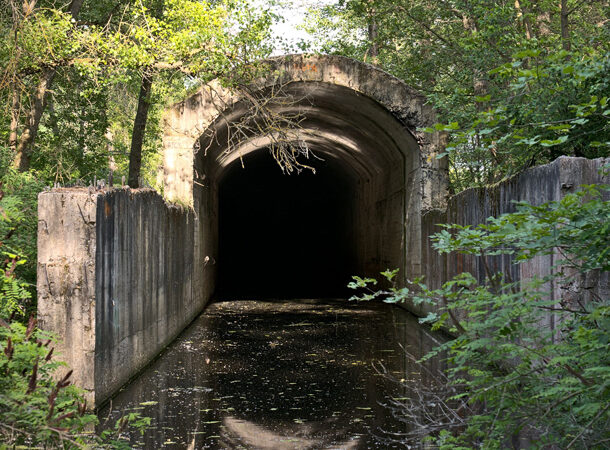 https://www.oneman-onemap.com/en/2019/01/20/the-stalin-tunnels/
https://www.oneman-onemap.com/en/2019/01/20/the-stalin-tunnels/ Kyiv in Ukraine has an extensive railway network and well-designed subway stations. However, it has an unfinished segment. During World War II, Stalin initiated the construction of two underground corridors as a secure alternative to the vulnerable bridges over the Dnieper River. Named Stalinsʹke Metro (Сталінське метро), these corridors were intended to ensure safe transportation during a potential siege. However, with the surrender of German forces, the project was abandoned. Today, eerie remnants of these unfinished corridors can still be found in certain areas of Kyiv; they are frequently flooded, poorly maintained, and adorned with stalactites.
Ross Island Penal Colony, India
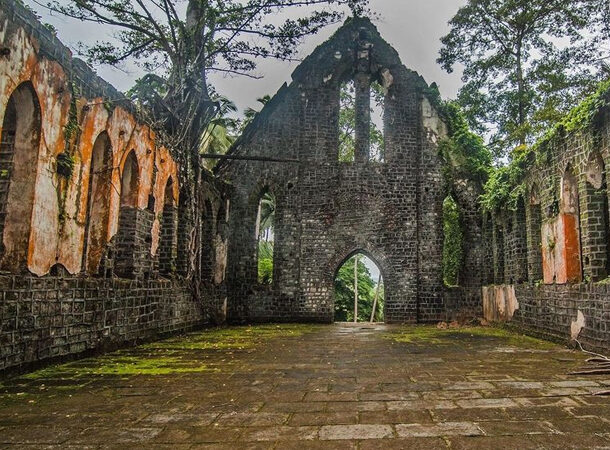 https://www.smithsonianmag.com/travel/indias-abandoned-island-colonial-horror-180960617/
https://www.smithsonianmag.com/travel/indias-abandoned-island-colonial-horror-180960617/ Ross Island is one of over 500 small islands within The Nicobar and the Andaman Islands. By the 1850s, British authorities in India began to use the island as a prison camp, primarily to hold and safeguard inmates from the 1857 Indian Rebellion. For years, inmates were forced to clear the island’s dense, humid forests to make space for an extravagant colonial complex. Malaria, cholera, dysentery, and other diseases were a constant danger. The British even conducted illegal medical experiments with an untested medication to cure malaria. Thousands of prisoners were force-fed cinchona alkaloid, which produced significant adverse effects such as nausea and depression.
Beelitz Heilstatten, Germany
 https://traveltriangle.com/blog/hitlers-abandoned-hospital-in-germany/
https://traveltriangle.com/blog/hitlers-abandoned-hospital-in-germany/ Kaiser Wilhelm II built the Beelitz Sanatorium in 1898 to address the city’s rising tuberculosis epidemic. Over 17,500 individuals were treated at Beelitz from 1914 to 1918, including the future Führer, Adolf Hitler. Several attempts to privatize the sanatorium in the late 1990s failed, with just a portion of the building finally being rebuilt as a neurological patient clinic. The sanatorium’s remaining sections were abandoned and have subsequently deteriorated due to criminal activity and sentimental collectors. To make matters worse, the site was also the location of several murders and the activities of a serial murderer known as The Beast of Beelitz.
Hashima Island, Japan
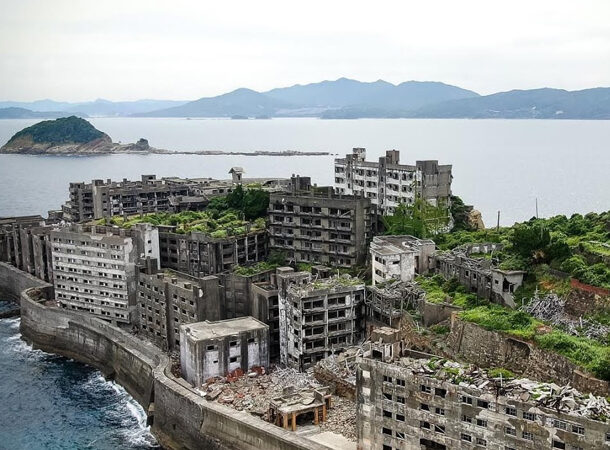 https://mysterioustrip.com/hashima-island-haunted-japan/
https://mysterioustrip.com/hashima-island-haunted-japan/ If you’re looking for a snapshot of what Earth would look like after a zombie apocalypse, Hashima Island is the place to go. Located nine miles off the coast of Japan near the city of Nagasaki, the island is one of the most haunted places on Earth. Over 1,000 of its former residents – brought there as slave labor in the 1930s and during World War II – died. The Chinese prisoners of war and Korean immigrants were forced to work in harsh conditions, and many starved to death or died from exhaustion. The island achieved World Heritage status in 2015, only after Japan acknowledged its role in the forcible labor practices on the island.
The Orpheum Theatre, USA
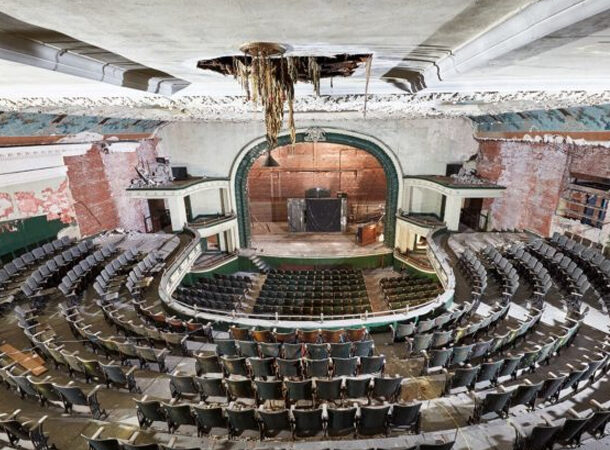 http://www.chuckdade.com/orphinc/html/history.htm?fbclid=IwAR3JH1NWJS9-RtCWY4dqk_fECE76CbIgLOlGgEfcX45O7Pt6vuR13u_MOK0
http://www.chuckdade.com/orphinc/html/history.htm?fbclid=IwAR3JH1NWJS9-RtCWY4dqk_fECE76CbIgLOlGgEfcX45O7Pt6vuR13u_MOK0 The Orpheum Theatre in Madison was erected in 1926 for $750,000, a massive amount of money at the time. Its grand opening coincided with the Titanic’s sinking, setting the tone for the theater’s spectacular demise. The theatre offered a variety of shows and films, but their entertainment value paled in comparison to what happened after the theater closed at night. The night housekeeper, who was the last person to leave the building each day, related a series of bizarre happenings. He would overhear discussions at the bar and would frequently come across a shadowy figure cleaning beside him, whom he believed to be the late head usher who died after falling from the balcony. There were also rumors of people seeing a man seated beneath the balcony in the main theater, who habitually appeared and disappeared.
La Isla de las Muñecas, Mexico
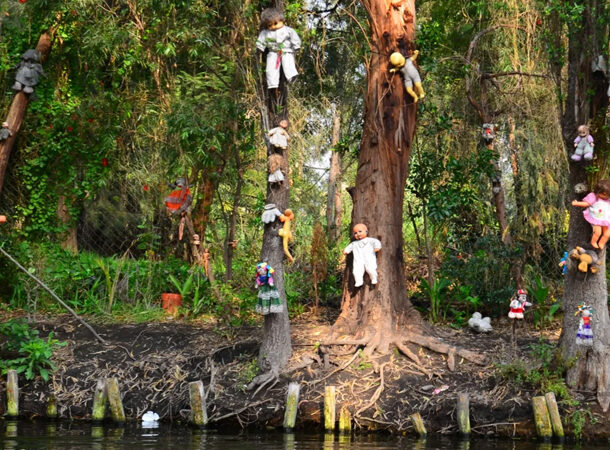 https://nypost.com/2021/10/30/real-story-behind-haunted-island-of-the-dolls-in-mexico/
https://nypost.com/2021/10/30/real-story-behind-haunted-island-of-the-dolls-in-mexico/ The Island of the Dolls is one of the world’s most eerie and terrible places and can be found deep within the canals of Xochimilco, Mexico City’s last vestige of the Aztecs. Here, the locals believe the land is cursed, and they often see ghosts walking and hear shadows talking. The single acre of land has three cabins and hundreds of decaying dolls. The caretaker started collecting the dolls when he discovered a drowned girl on the island, and he hung the old dolls in the trees all over the island to appease the girl’s soul. Later, in 2001, the caretaker was discovered dead in the exact location where he claimed to have found the girl’s body. Nobody lives on the island at the moment. Visitors to the island claim to have seen the dolls’ eyes move and heard them communicate.
Hotel del Salto, Colombia
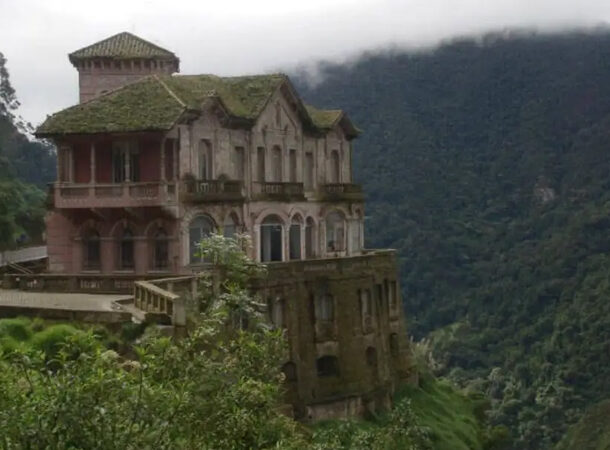 https://www.thevintagenews.com/2016/08/06/colombias-haunted-hotel-del-salto-despite-beauty-papers-reported-several-cases-suicides/?chrome=1
https://www.thevintagenews.com/2016/08/06/colombias-haunted-hotel-del-salto-despite-beauty-papers-reported-several-cases-suicides/?chrome=1 There is a very spooky backstory behind the now-abandoned Hotel Del Salto, also known as the Tequendama Falls Hotel in Cundinamarca, Colombia. The myth and folklore surrounding the place speak of indigenous tribespeople leaping into the waterfall during the Spanish Conquest, believing that they would shapeshift into eagles and be able to fly away. The hotel has also witnessed numerous suicides, and rumor has it that all hell breaks loose after 5 pm when whispers of screams and fleeting shadows appear in the long abandoned rooms of the hotel. Guests have reported witnessing apparitions and hearing strange voices in an unfamiliar language, quite possibly those of the departed Muisca.
Old Diplomat Hotel, Philippines
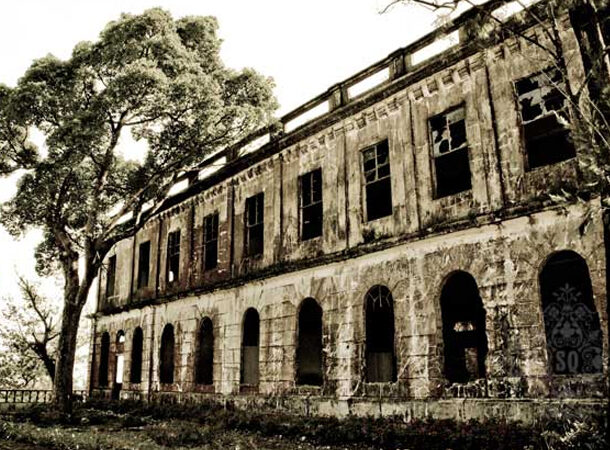 https://www.atlasobscura.com/places/haunted-diplomat-hotel
https://www.atlasobscura.com/places/haunted-diplomat-hotel Many people are misled by this hotel’s name, believing that diplomats or other high-ranking officials have visited or stayed on its premises. It could not be further removed from the truth. Originally built by Dominican friars, the Japanese army occupied the hotel during WWII and it was the site where atrocious acts of murder, torture, and rape were committed against prisoners and refugees. The US bombed a part of the structure near the war’s end. Following that, a luxury hotel group purchased and renovated the war-torn structure from the government. The hotel closed down when the owner died a few years later. The hotel is said to be haunted by victims of the Japanese army’s horrific crimes.
Villa de Vecchi, Italy
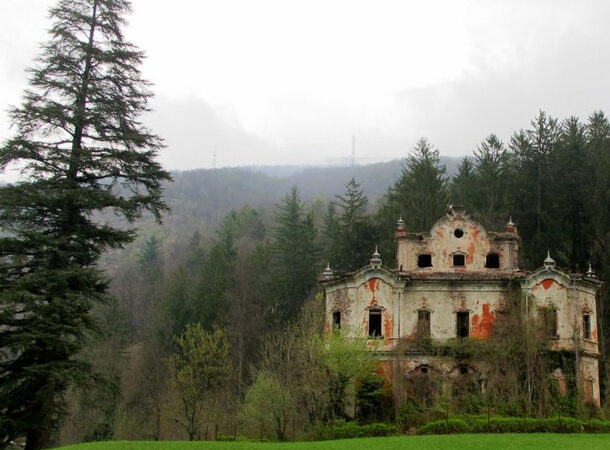 https://houseandhistory.com/villa-de-vecchi/
https://houseandhistory.com/villa-de-vecchi/ The foreboding “House of Witches” near Lake Como, Italy, was built as a holiday home for Count Felix De Vecchi between 1854 and 1857. The family only enjoyed a few years in their new home before tragedy struck. First, the architect died a year after the building was completed. Then in 1862, Count De Vecchi came home one day only to find his wife had been murdered and his daughter missing. The count searched for his daughter for over a year and finally committed suicide when he couldn’t find her. His brother then moved into the house, where he, and his family remained until WWII. The house has been empty since the 1960s, and an avalanche in 2002 destroyed all the homes in the neighborhood… Except this one. Creepy.
Hovrinskaya Hospital, Russia
 https://www.rbth.com/lifestyle/329482-creepy-hospital-moscow
https://www.rbth.com/lifestyle/329482-creepy-hospital-moscow This hospital, built in the shape of a biohazard symbol, is at the top of the list when it comes to urban legends. This infamous location has been the subject of terrible tales, with some arguing that its development was abruptly halted due to budgetary constraints. In contrast, others believe that local authorities intervening against a satanic cult caused the rise of an unsettling presence or entity in the building. In addition to being a well-known haven for Satanists, the building was also no stranger to paranormal activities, and weird shadows would often be seen moving in dark rooms without any light. The entire structure was eventually covered in graffiti and completely dilapidated. The building finally met its end in 2018 when it was demolished.
Poveglia Island, Italy
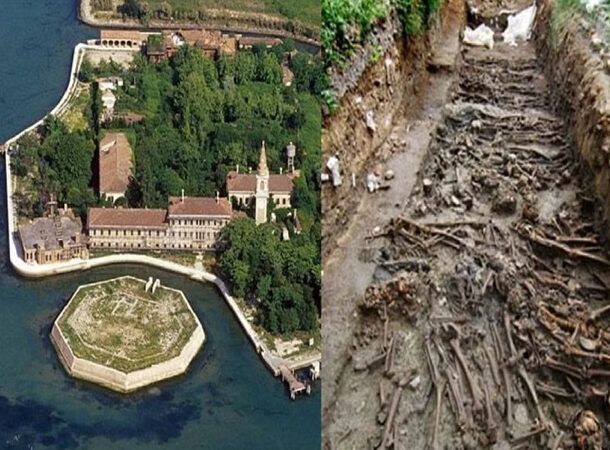 https://www.news.com.au/travel/destinations/europe/italy/poveglia-island-italy-inside-worlds-most-haunted-island-photos/news-story/54a221461e6526d1cf52f92b7bd87e4a
https://www.news.com.au/travel/destinations/europe/italy/poveglia-island-italy-inside-worlds-most-haunted-island-photos/news-story/54a221461e6526d1cf52f92b7bd87e4a The abandoned Plague Island of Poveglia is believed to be so evil that few Italians venture to set foot there. In fact, fishermen refuse to fish in the waters surrounding the island, and access was restricted for many years. Though numbers vary, more than 160,000 people are believed to have died on Poveglia, and they didn’t go quietly. Being taken to Poveglia was essentially a death sentence, and people would resist vehemently, knowing they would spend their final days in a literal hell on earth. Some claim that the soil on the island is 50% ash due to all the cremations that had to take place as they burned the plague victims.



























